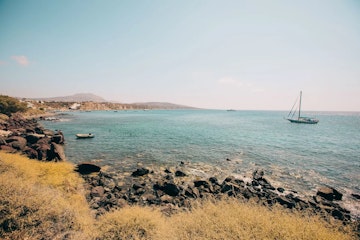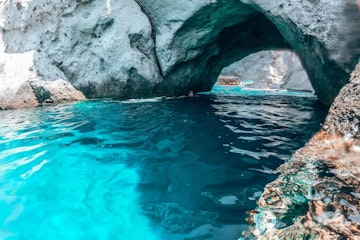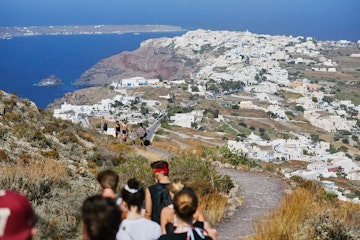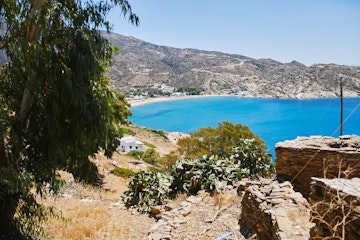Our guide to Santorini runs through all the ins and outs of this stunning island, where ancient history, unforgettable sunsets, and modern luxury collide.
Oh, Santorini – the jewel of the Aegean. There are loads of reasons why this island is the most-visited in the whole of the Cyclades chain, and one of the most-visited in the country (only Crete can muster more).
For one, just look at it! The whole place is set on a collapsed volcano, with cinnamon-tinted rock rising straight out of the clear seas to craggy summits where chalk-white villages drift like clouds along a caldera rim. Up there, towns like Oia and Thira are now the stuff of legends, fodder for travel brochures the world over. They host bougainvillea-strewn tavernas, luxury cave hotels with infinity pools, and mysterious Orthodox churches that bring a blaze of turquoise blue to the skylines.

Yep, it's hardly a wonder that Santorini is now one of the first names on any Greek island-hopping itinerary. Come here to witness sunsets that blaze ochre and vermillion across a boat-dotted sea. Choose this one for rust-red beaches and dramatic sailing trips to smoke-belching volcanic islands. Come to explore one of the country's most iconic destinations.
Where is Santorini, Exactly?
Santorini is often said to be smack dab in the heart of the Greek Aegean. Roughly midway between Crete (the largest and southernmost island) and the capital of Athens, it's one of the most famous islands in the Cyclades chain. Its nearest neighbours are relatively unknown Anafi just a touch to the east, and the party island of Ios, which sits around 11 miles to the north.

When to Visit Santorini
Santorini is downright stunning no matter the time of year. However, we'd say that the best time to visit is during the shoulder season months of April and May, or September and October. The crowds thin out just enough for you to enjoy a touch of solitude on the pebble coves then, while the bars and tavernas and hotels that offer caldera views won't be anywhere as near as busy (or expensive!).
Santorini in Summer
The peak season in Santorini gets rolling in earnest by early June. It's a great time for the sun seekers and the tanners, because daily averages in this part of Greece sit plum in the upper 20s and low 30s. There's often simply zero rainfall and cloud coverage, too, which means you're all but guaranteed those jaw-dropping sunset shows in the evening. The downside here is that you'll need to contend with booming visitor numbers. The vast majority of Santorini's 500,000 annual arrivals come during this balmy season.

Santorini in Autumn
For us, there's simply no better time to be in Santorini – scratch that, anywhere in Greece! – than during the autumn. Yes, the temperature dips a touch, but only to a positively-pleasant 22-25 degrees. On top of that, the crowds go to just a fraction of what they were only a month before, which kicks down the hotel rates and the cost of flights (stats show November is one of the cheapest months of the year to fly in from London, for example). The only real downside is the chance of chilly evenings and some rain.

Santorini in Winter
Don't discount a trip to Santorini in winter. Okay, so you'll need the woollies and a raincoat, because there are some downpours (although average rainfall is just 44mm in December – a tenth of what it is in Wales!). The upside is that crowds are about a fifth of what they are in June and July. Everything from the lookout points to the hiking trails has a deserted feel to it. Only the bravest will swim in the Aegean in the winter, mind, and lots of tavernas and hotels close completely for the season.

Santorini in Spring
Spring is another sweet spot for island-hopping your way to Santorini. Temperatures work their way from an average high of 16 in March to a laze-on-the-balcony 22 in May. Meanwhile, average flight prices from London hover around the £190 return mark – about 30% less than in the high summer. Sailors and yachters particularly like the spring because of the strong and regular winds, but it's also fantastic for foodies and wild swimmers looking to dodge the rush of June.

Things to Do in Santorini
We'll be honest – Santorini isn't your usual kick-back-and-relax Greek island. Everything from sailing trips to snorkelling adventures to wine tasting awaits in these parts, making it a fantastic destination for more adventurous and active types. That's not to say there isn't any R&R on offer. It's just that most of the chilling is done in sleek tavernas or by the poolside of your boutique cave hotel. Anyway, here's a look at all the top things you should totally have on the to-do list…
Ancient Thera
Ancient Thera soars high on the peaks of the Mésa Vounó mountain, on the far eastern edge of Santorini. It's far away from the famous cave hotels and infinity pools, offering a glimpse at the rich ancient past of the island. Excavations have revealed traces of human habitation at the spot going back to the 7th millennium BC! You can do tours of the dig site to see the remnants of an old theatre, a forum, a marketplace and several bathhouses. Oh, and the views up there are spectacular to boot.

Go Diving
Everywhere in the Aegean is a potential dive destination, but Santorini manages to take things to the next level. The rocky nature of the island means that the surrounding waters stay very clear, which increases underwater visibility. In fact, average visibility in these parts hits a whopping 40m. More than that, Santorini is known for its volcanic dive sites. They include a long-lost shipwreck around the rock formations of Nea Kameni island and the magma clusters of the Faros Reef.

Fira to Oia Hike
Some say that the Fira to Oia hike is the best hike in Greece. We wouldn't go that far (this is the home of Mount Olympus, remember?) but it's certainly a fantastic ramble. The route links up two of the most beautiful villages on the island, skirting the top of the famous caldera rim as it goes. It's around four hours in total, weaving through church-topped towns like lovely Imerovigli and over historic donkey trails with gorgeous views. Be sure to take the detour to Skaros Rock if you've got time – it looks more Sri Lanka than southern Med!

Tastings at Santo Wines
Wine buffs will be pleasantly surprised to see that Santorini is one of Greece's official viticulture regions. It's thought that wine has been made in these parts since ancient Roman times. There's mineral-rich volcanic soil to help with all that, and now a handful of pretty spectacular wineries that perch high on the cliffs. One of the top-rated spots is Santo Wines, which has a wrap-around terrace to offer a backdrop of sea and cloudless skies for tasters. Talk about romantic!

Sailing Trips
No guide to Santorini could possibly be complete without mentioning the epic sailing that happens around this island. You don't have to be a seasoned skipper to enjoy it, either. There are loads of day trips on catamarans or pirate ships that whisk you out of the port at Órmos Athiniós in the early morning. Stops typically include the smaller volcanic island of Nea Kameni in the caldera, and Nisis Palaia Kameni, where you can bathe in strange coastal hot springs.

The Best Beaches in Santorini
This land of high-perched lux hotels and strange volcanic mountains isn't actually that famous for its beaches. And it's true – Santorini isn't even close to the top beach destination in Greece. The only real stretches of sand are on the remote east coast. Those on the caldera side are mainly cliff-backed coves that can be a nightmare to get to. That's not to say there aren't some corkers. There are, and no self-respecting guide to Santorini could ignore…
Red Beach
Red Beach can be hard to find. It lurks at the base of a huge cliff south of the ancient town of Akrotiri. A rocky path wiggles down from a car park above, soon revealing a thin sliver of black-sand beachfront that's framed by high walls of scarlet stone on all sides. The effect is to make the Aegean look bluer and clearer than ever. One warning: Red Beach draws in the biggest crowds, so you might want to consider some alternatives during the high season…

White Beach
White Beach is just one headland around from Red Beach. But the colours of the rock change dramatically as you sail past the ochre-tinged cliff, switching to a shimmering alabaster that glints in the beating sun. White Beach is always way less busy on account of the fact that you have to get a boat taxi there. The beach itself is actually made up of black pebbles, but the cliffs behind are as white as clouds.

Kamari Beach
Kamari Beach sits on the remoter, less-trodden east coast of Santorini. It's more your classic vision of relaxed Greek sand, with umbrellas and sunbeds strewn out before a lightly lapping Aegean. Again, it's got dark, volcanic sand, but also oodles of amenities – there's a dedicated lifeguard here in the main season, along with outdoor showers and a couple of tavernas to boot. It's the perfect place for families.

Perissa Beach
The coffee-coloured powder of long and wide Perissa Beach skirts the south-eastern edge of Santorini. Again, that puts it away from the crowds. However, it's still a firm family favourite on account of the buzzy beach bars and the affordable accommodation that sits in the town just behind. Blue-flag Perissa is also famed for its clear waters, which draw lots of swimmers and snorkelers.

Pori
Unlike many of the other east-coast beaches on Santorini, Pori has golden sand and red-tinged cliffs floating high above. You get there by heading east from Oia past the dramatic Columbo Cape, though pockets of rough farm fields and vineyards carved into the volcanic mountainside. This guide to Santorini would call it one for those who are keen to escape the crowds and go off the beaten path.

How to Get to Santorini
There are really only two ways you can reach Santorini: By sea and by air. Thankfully, because this one is firmly among the top three most popular destinations in the country, there are plenty of flight and ferry connections. What's more, Santorini remains well linked to Athens by plane and boat during the low season, which isn't true of many of the other, more-seasonal Cyclades isles.
Santorini Ferries
Santorini is now a major destination on most Greek island-hopping itineraries. The upshot? It's something of a transportation hub for ferries heading in and out and across the Aegean. You can usually rest assured there's a route that will suit, no matter if you're coming in fresh from seeing the Acropolis in Athens or just jumping over from a nearby island like Milos or Folegandros. Here are some of the most popular ferry routes into Santorini:

- Athens to Santorini (€32-70/4-7 hours)
- Mykonos to Santorini (€40-55/2-3 hours)
- Milos to Santorini (€18-55/2-5 hours)
- Popular island-hopping routes around the Cyclades
- Crete to Santorini (€25-60/2-6 hours)
Santorini Flights
The Santorini National Airport, also known as the Thira Airport, or just Santorini Airport, has risen and risen in recent years to become one of the major arrival points for the central Aegean. It now caters for just over 2.5 million passengers annually. Many of the arrivals are charter flights that run seasonally between May and August. However, there are also year-round domestic and international routes on both low-cost and flag-carrying airlines.

Check out:
- Aegean Airlines – For the best domestic links within Greece, mainly to Athens and Thessaloniki
- Alitalia – Direct links to Rome
- easyJet – Seasonal links from major UK cities
- Jet2.com – Seasonal links from major UK cities
- Ryanair – Some of the lowest-cost fares to Santorini. Largely seasonal
This guide to Santorini offers insights into the top beaches, ways to reach this stunning Cyclades island, and some of the bucket-list-busting things to do. Be sure to get in touch for more information on Greek island-hopping trips that include the amazing ancient volcano that is Santorini!


